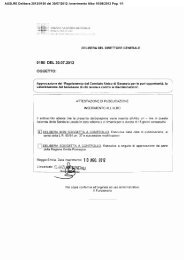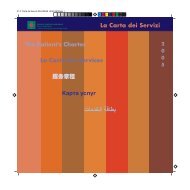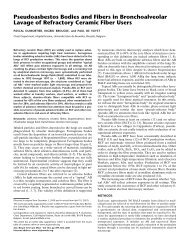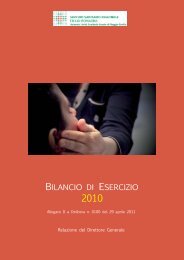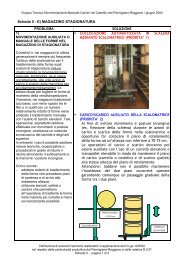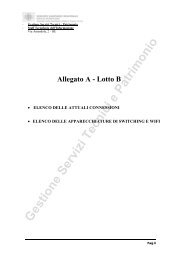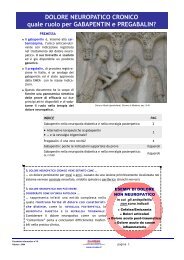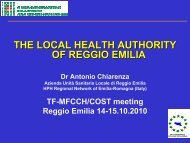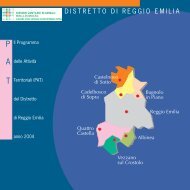Download PDF
Download PDF
Download PDF
- No tags were found...
You also want an ePaper? Increase the reach of your titles
YUMPU automatically turns print PDFs into web optimized ePapers that Google loves.
Home-based interventions for postpartum depression 5MethodsPubMed, PsycInfo, Embase, and CINAHL databases weresearched from their inception to February 2008 usingcombinations of the terms home-based, home visiting,home visitation, home visit, depression, postpartum depression,postnatal depression, perinatal depression, prevention,treatment, intervention. The search was limited topeer-reviewed studies published in English. In addition,studies referenced in relevant published articles and reviews(Dennis and Creedy 2004; Dennis and Hodnett 2007;Lumley et al. 2004) were assessed.To be selected for inclusion, a study was required tomeet the following criteria: (1) assessment of a home-basedpsychological intervention in which prevention or treatmentof PPD was a primary or secondary goal, (2) study sampleof pregnant women or women with a child < 1 year old, (3)randomized controlled trial design, and (4) publication in apeer-reviewed journal. Literature reviews, meta-analyses,and case studies were excluded.Our initial search yielded 24 abstracts that appeared tomeet the specified inclusion criteria; those articles wereobtained and reviewed. Upon closer review of those 24studies, seven were excluded because they reported on nonpsychologicalinterventions (Armstrong et al. 1999;Armstrong et al. 2000; Fraser et al. 2000; Gelfand et al.1996; Morrell et al. 2000; Navaie-Waliser et al. 2000;Roman et al. 2007), one was excluded because the samplewas not restricted to mothers of children less than 1 yearold (Beeber et al. 2004), one was excluded because therewas no comparison group (Ammerman et al. 2005), twowere excluded because assignment to intervention orcontrol was not randomized (Austin et al. 1999; Cullinan1991), two were excluded because they combined resultsfor home-based and clinic-based services (Wickberg andHwang 1996; Zayas et al. 2004), and another four studieswere excluded because there was not enough informationgiven to determine the specific type of interventionemployed (Koniak-Griffin et al. 2002; Marcenko andSpence 1994; Marcenko et al. 1996; Tezel and Gözüm2006). An overview and critique of the six articles meetingcriteria for inclusion in the review are presented below.ResultsTable 1 displays the location, dates, intervention approach(i.e., prevention or treatment), sample description, interventiondesign, intervention provider, and control condition(s)for each of the six articles reviewed. Only one study reportedon a home-based intervention to prevent PPD (Wiggins etal. 2005); the remaining five studies described home-basedinterventions to treat PPD (Appleby et al. 1997; Chabrol etal. 2002; Cooper et al. 2003; Holden et al. 1989;Prendergast and Austin 2001). Most studies recruitedcommunity-based samples, with only one trial recruiting asample of women determined to be at high risk fordepression as a function of neighborhood socioeconomicdeprivation (Wiggins et al. 2005). Intervention lengthranged from 5 weeks to 1 year with most lasting 6 to8 weeks. Three studies used health visitors as interventionists(Appleby et al. 1997; Holden et al. 1989; Wiggins et al.2005), one used nurses to deliver the intervention(Prendergast and Austin 2001), one used masters-leveltherapists (Chabrol et al. 2002), and one used a combinationof mental health clinicians and health visitors (Cooperet al. 2003).Two studies employed non-directive counseling, alsocommonly referred to as “listening visits”, as theirintervention (Holden et al. 1989; Wiggins et al. 2005).Non-directive counseling is based on principles of Rogeriantherapy and the assumption that talking to a supportiveprofessional “will help people take a more positive view ofthemselves and their lives” (Holden et al. 1989, p. 224).The role of the counselor in non-directive counseling is toaid in exploration and understanding of feelings but not tooffer judgment or advice (Dennis and Hodnett 2007). Threestudies assessed interventions that used cognitive behavioraltherapy (CBT) techniques (Appleby et al. 1997; Chabrolet al. 2002; Prendergast and Austin 2001). CBT techniquesinclude modification of negative and dysfunctionalthoughts, as well as strategies to increase pleasant activitiesand decrease behaviors leading to low mood (Beck et al.1979; Lewinsohn et al. 1986). One study compared nondirectivecounseling to CBT and psychodynamic therapy(Cooper et al. 2003). Psychodynamic therapy is a broadbasedcategory that includes diverse treatments and explanatorymodels derived from Freudian and post-Freudiantheories (Gibbons et al. 2008). Psychodynamic approachesgenerally emphasize exploration of early experiences andattachments to provide insight into current functioning.Study findings are described below. Table 2 presents asummary of study results, as well as depression measuresused and analyses conducted (e.g., intention-to-treat).Non-directive counseling studiesOne of the two non-directive counseling interventions wasreported to be effective in preventing or treating PPD. Thefirst trial of non-directive counseling was conducted byHolden and colleagues in 1989. Women who scored > 12on the Edinburgh Postnatal Depression Scale (EPDS; Coxet al. 1987) 6 weeks after delivery, and met researchdiagnostic criteria for minor or major depression 12 weeksafter delivery on Goldberg’s Standardized PsychiatricInterview (Goldberg et al. 1970), were randomized to



